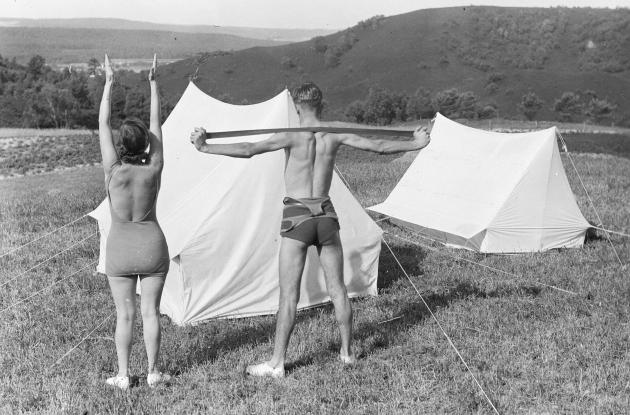The Danes in motion – gymnastics on radio and TV
For almost 100 years, gymnastics broadcasts on radio and TV have kept Danes moving. In DR-arkivet you can now find thousands of these broadcasts. Here we delve into the history of interval gymnastics.
Early one morning in 1952, many Danes were standing in front of the radio in their living rooms. They listened as Jesper Peter Jespersen (1883-1963) – better known as Kaptajn Jespersen (captain Jespersen) – thanked a large number of people for their help and support for his radio programme. This broadcast would be his last. It put an end to his 25-year career as a radio host on “Morgengymnastikken” (morning gymnastics).
When the Captain had finished his thank-you speech, which was not least directed at his faithful listeners, the training began:
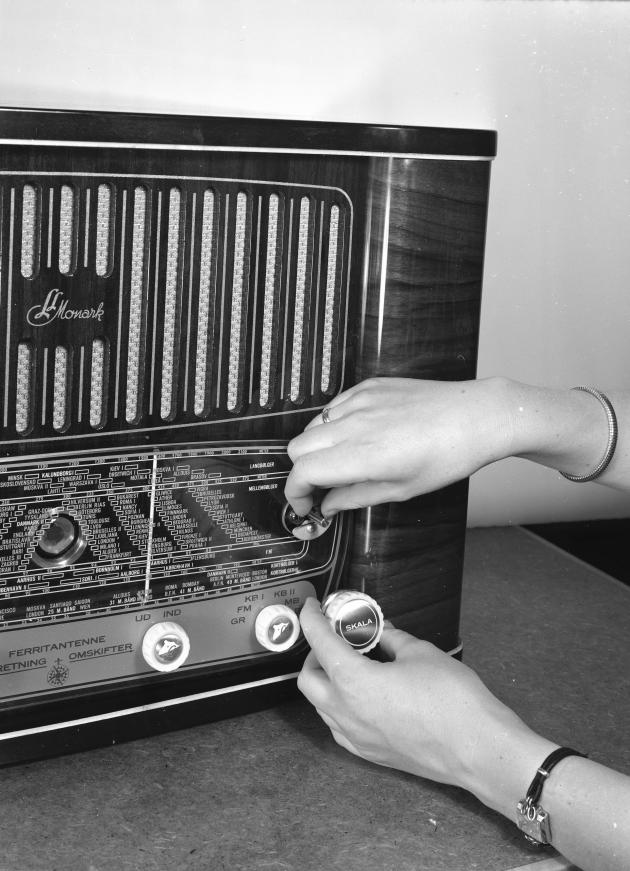
Photo: John E. Carrebye (1911-1995)
““Let us then create steel in our arms and thought and brilliance in our eyes and straighten our backs. We grasp the staff, which is a sharp weapon against all that would break down. It must be washed clean - remember that! - and it must be longer than your arms. We stretch our arms forward, hold the staff so high that we can see ahead under it. Then we swing our legs forward, alternately left - a pause in posture - right, and so you will continue! The leg you are standing on must be kept straight.
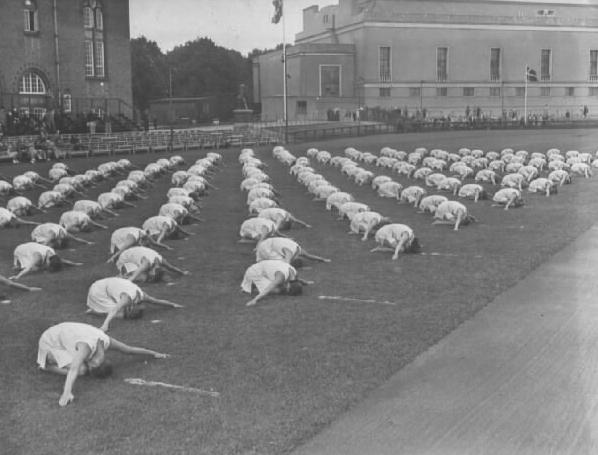
Photo: Holger Damgaard (1870-1945)
Every weekday morning, the Captain had stood in front of the microphone and woke up the Danes with knee lifts, jumping jacks and big arm movements.
Jespersen was the beginning of gymnastics broadcasts in Denmark. Since then, they have taken many forms: from radio programmes and TV broadcasts to live streams on social media. They have one thing in common: they bring Danes together in motion - despite differences, busy routines and distance.
Captain Jespersen – the man who got the Danish men up and running
In the 1920s – before he stood in front of the microphone – Jesper Peter Jespersen worked for Berlingske Tidende, where he wrote articles about personal hygiene and gymnastics.
The idea of gymnastics on the radio did not come from the Danish State Radio itself, but from Berlingske Tidende. It was the newspapers that produced the radio news at the time. And on 5 September, 1927, Captain Jespersen stood at the microphone in the Danish State Radio studio for the first time.
Captain Jespersen's voice could now be heard on the radio every morning, Monday through Friday, for many years to come. At the time, it was one of the few programmes that was broadcast during the daytime. After 25 years, Captain Jespersen retired, but the programme continued with another host until 1967 under the name "Morgengymnastik for Mænd" (morning gymnastics for men).
Gymnastics is for women too
But what about the women and children? Of course, they had to move too.
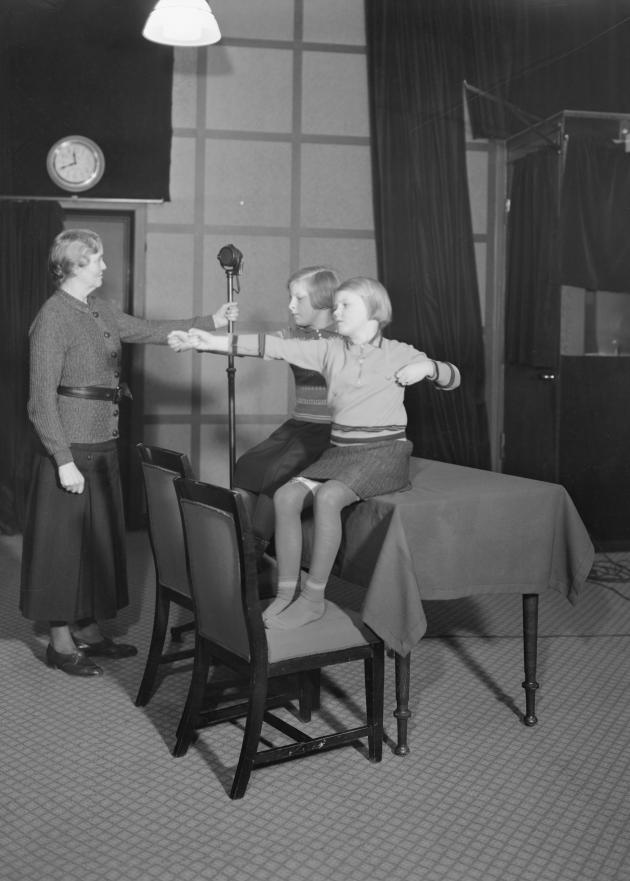
Photo: Elfelt & Co.
In 1932, Else Thomsen introduced gymnastics for schoolchildren, and the following year Henriette Riskær became the host of “Morning Gymnastics for Women”. This programme was broadcast fifteen minutes earlier than the men’s gymnastics. It was based on the idea that women often got up earlier to do the morning chores and send the children to school.
In 1941, “Gymnastics for Housewives” followed. The host was the gymnastics teacher Viola Nørløv, and the programme was broadcast later in the morning, at 9 a.m. The time was convenient for housewives, as there was more peace at home to take a short break from the day’s duties. The programme was tested on television in the spring of 1952. However, it was only broadcast once, as it was found that the exercises were too difficult to follow on the small TV screen.
Gymnastics teacher Helle Gotved (1912-2006) became a leading figure in gymnastics from the 1950s, both on radio and television. From 1953 she hosted several radio programmes about gymnastics and health, and in 1966 her most successful radio programme began: "Ha' det bedre", which was broadcast until 1991.
Gotved published books, founded the Gotved Institute and, together with Anne Marie Helger, created the television programme "Helle og Helger" from 1993 to 1994, shortly before she turned 80. In the programme, Helle Gotved teaches easy-to-understand gymnastic exercises with Anne Marie Helger as the performing student.
From morning exercises on the radio to livestreams on Instagram
It was not until the 1970s that the programmes began to address both men and women at the same time. This was the case, for example, with both “Morgenmotion” (1969-1979) and “Pausegymnastik” (1977-1978), which both had both male and female hosts. “Pausegymnastik” was produced by the Ministry of Education and was intended for the workplace. The programme was broadcast at 11:05 and 14:05 on weekdays on P3, so that people could use it as a break from work.
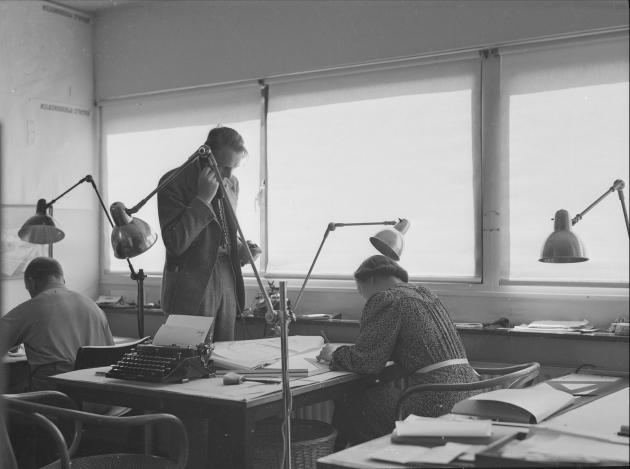
Photo: John E. Carrebye (1911-1995)
The reason was that work for many was more sedentary than it had been before. By doing interval exercises, people could stay healthy and prevent injuries. It was therefore a gain, not only for the individual, but also for the workplace, as the exercise resulted in fewer sick days and more job satisfaction.
Common to all gymnastics programmes over time is the short duration of 5-10 minutes and the easily accessible exercises that do not require much space or changing clothes. This way, everyone can participate.
Today, there are no longer regular gymnastics broadcasts on radio or TV. However, they have appeared every now and then. For example, DR3 revived the tradition of morning gymnastics in 2014 and DR Ramasjang followed with children's programmes such as "Gang i Stuen" in 2011 and "Op og hop" in 2015.
““Are you ready out there? Good! Then we'll stretch our flying arms and get ready for takeoff! Are you ready, captain? Good! Then we'll do it! … Can you hear that? It sounds like France! ... You land by lying down on your stomach, like this, and still with your arms outstretched, if you can…
Gymnastics also emerged in a different format during the Covid epidemic. Here, Melvin Kakooza went live on Instagram several times in 2020 while practising “Coronafitness,” encouraging others to move as well.
There is a long tradition of coming together – even for a short while – to exercise and protect our common health. The joint training during Covid and the many gymnastics programmes testify that we actually have a need for it. A need for motion and a need for community.
Do you need to move your body?
DR-arkivet contains thousands of gymnastics broadcasts: interval gymnastics, morning gymnastics and much more.
